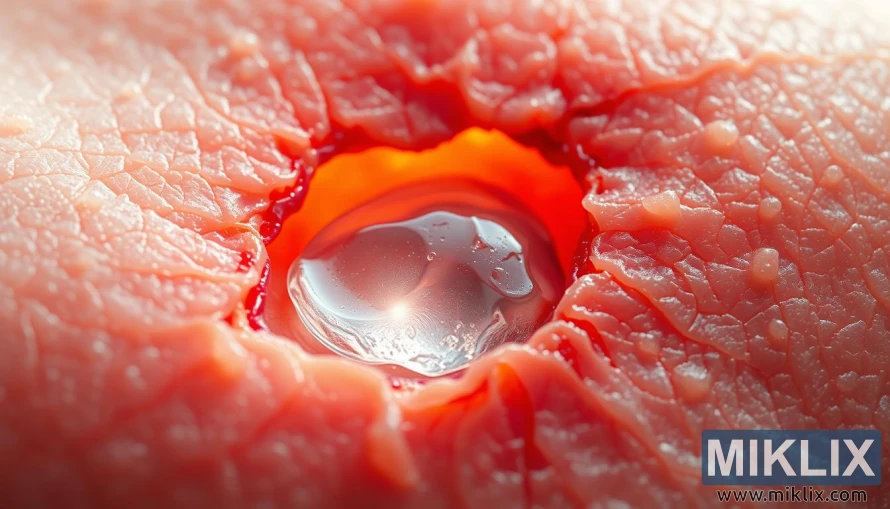Image: Hyaluronic Acid in Wound Healing
Published: June 30, 2025 at 1:56:52 PM UTC
Last updated: September 26, 2025 at 3:28:52 PM UTC
Close-up of wounded skin showing hyaluronic acid supporting healing, boosting cell repair, and promoting collagen for restoration.
The image provides an intimate, hyper-detailed portrayal of the skin’s natural healing process, capturing the raw vulnerability of a wound alongside the regenerative potential of hyaluronic acid. At the center of the composition lies a shallow injury where the outer epidermal layer has been disrupted, peeling back to expose the sensitive dermis beneath. The torn edges of skin curl slightly, their texture rough and uneven, evoking both the fragility and resilience of human tissue under stress. The surrounding surface reveals intricate microtextures of the epidermis, marked with tiny creases and natural variations, rendered in warm pink and reddish tones that emphasize the living, organic quality of the skin. These details, though visceral, establish an immediate sense of realism, immersing the viewer in the complexity of the body’s repair mechanisms.
At the heart of the wound, a translucent droplet glistens with a luminous clarity, representing the presence of hyaluronic acid. This viscous, gel-like substance fills the wound bed with a reflective sheen, catching the soft glow of surrounding light and radiating a sense of both purity and vitality. The droplet appears almost alive, pulsating with potential energy, suggesting its crucial role in orchestrating the body’s healing response. Hyaluronic acid’s known functions—retaining moisture, guiding cell migration, and fostering an environment conducive to collagen synthesis—are symbolically represented in the visual glow emanating from the wound’s center. The light highlights not just the physical presence of the molecule but its dynamic, invisible influence on the tissue’s regenerative processes.
Surrounding the central droplet, subtle hints of vascular structures can be discerned beneath the dermal layer, their faint reddish glow suggesting the vital supply of nutrients and oxygen needed for repair. The interplay of warm light around the wound transforms what could be seen purely as damage into a symbol of resilience and recovery. It conveys the idea that even in moments of vulnerability, the body is equipped with extraordinary molecular tools like hyaluronic acid to restore integrity, strength, and function. The illuminated edges of the wound almost appear to be reaching inward toward the droplet, as though the tissue itself is responding to its presence, reinforcing the visual metaphor of active regeneration.
The lighting in the composition enhances this narrative further. A warm, natural glow bathes the scene, softening the visceral imagery and creating an atmosphere of calm assurance. The contrast between the torn textures of the skin and the smooth, luminous droplet in the center underscores the transformative role hyaluronic acid plays, bridging the gap between injury and healing. This balance between fragility and renewal, destruction and repair, gives the image an emotional weight, inviting the viewer to reflect not just on the science of tissue regeneration but on the body’s innate capacity for resilience.
Taken as a whole, the scene conveys a powerful message: hyaluronic acid is not merely a supportive molecule but an active participant in the body’s defense and restoration. Its presence in the wound symbolizes both immediate relief and long-term recovery, highlighting its critical role in reducing inflammation, encouraging cellular activity, and promoting collagen formation. The detailed textures, the glowing center, and the interplay of light all come together to create a narrative of hope, healing, and the extraordinary regenerative power embedded within the human body. Through this depiction, the image elevates hyaluronic acid from a biochemical concept to a symbol of life’s persistent drive to mend and renew itself.
The image is related to: Hydrate, Heal, Glow: Unlocking the Benefits of Hyaluronic Acid Supplements

